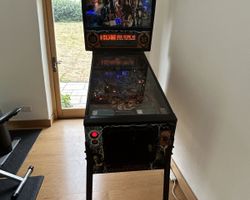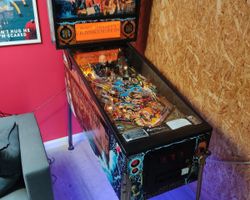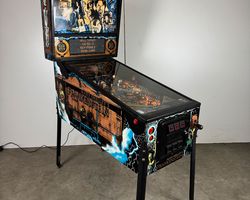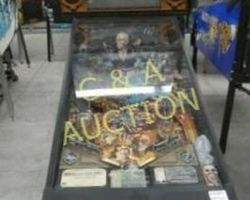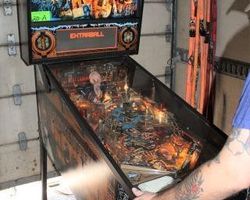Mary Shelley's Frankenstein
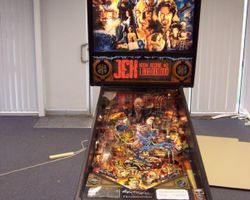
Average Prices: USD $800 to $2,400
Produced: January, 1995
Production Run: 3,000 units
Machine Type: Solid State Electronic
MPU: DataEast/Sega Version 3b
Players: 4
Design by: John Borg
Art by: Paul Faris
Dots/Animation by: Kurt Andersen, Jack Liddon, Scott Melchionda
Music by: Brian Schmidt
Sound by: Brian Schmidt
Software by: John Carpenter, Neil Falconer, Orin Day
"Mary Shelley's Frankenstein," released in January 1995 by Sega Pinball, Inc., stands as a compelling testament to thematic integration and mechanical ingenuity within the realm of solid-state electronic pinball machines. This creation draws its essence from the classic horror narrative, translating the dark, atmospheric world of Mary Shelley's literary masterpiece and its cinematic interpretations into a tactile, high-energy gaming experience. Its development was a collaborative effort, with John Borg crafting the game's design, while Paul Faris lent his artistic vision to the playfield and cabinet. The immersive soundscape, featuring custom speech by Fred Young and notably incorporating Edgar Winter's instrumental "Frankenstein," was shaped by Brian Schmidt, who also composed the musical score. Software development, crucial for the machine's interactive features and progression, was managed by John Carpenter, Neil Falconer, and Orin Day, with vivid animations for the large display executed by Jack Liddon and Kurt Andersen. Produced with a run of approximately 3,000 units, this Model Number 36 machine quickly found its place in arcades and private collections, powered by the DataEast/Sega Version 3b MPU, a robust platform for its era. A unique aspect of its production history involves its role as a testing ground; while officially a four-player game, the machine's display code was prototyped to accommodate six players, a feature later fully realized in subsequent Sega titles like "Baywatch." Observant players might also notice a playful nod within its display animations: Sonic The Hedgehog depicted with Frankenstein's signature scars during specific video sequences.
Distinctive Elements and Engineering
The design of "Mary Shelley's Frankenstein" is characterized by several mechanical and aesthetic elements that differentiate it within the pinball landscape. Foremost among these is the Frankenstein creature model, positioned centrally on the playfield. This animated toy possesses the unique ability to physically interact with the pinball, seizing it and then launching it towards the flippers or pop bumpers. This mechanism introduces an unpredictable and dynamic layer to gameplay, demanding swift player reactions and creating moments of surprise and intensity that directly tie into the machine's monstrous theme. Beyond this central figure, the machine boasts a larger 192x64 pixel dot matrix display (DMD), a significant upgrade for its time. This expanded canvas allowed for more detailed, fluid, and thematic animations, enhancing player immersion through visually rich storytelling and responsive feedback. The game also features an automatic plunger, contributing to a smoother, faster game start and allowing players to focus immediately on the first shot. These features collectively contribute to an engaging experience, where the physical presence of the monster and the vivid digital animations work in concert to deepen the player's connection to the Frankenstein narrative.
Playfield Architecture and Visuals
The playfield layout of "Mary Shelley's Frankenstein" is engineered for fast, flowing gameplay, balancing accessible shots with demanding precision targets. The core of the playfield features three flippers: two at the standard bottom position and a third, strategically placed upper flipper that enables specific lucrative shots. A single main ramp serves as a critical shot, leading to score multipliers or mode progression. The layout incorporates four pop bumpers, which are instrumental in creating chaotic, high-scoring ball action, particularly when the monster toy throws the ball into their vicinity. A spinner target, a vertical up-kicker (VUK), and a kickback mechanism further diversify the shot opportunities and add to the strategic depth. The playfield's design philosophy prioritizes a sense of momentum, encouraging players to chain shots together and maintain ball control amidst the game's challenging pace. Artwork by Paul Faris permeates the playfield, depicting scenes and characters from the Frankenstein story with a dark, gothic aesthetic that complements the machine's horror theme. The visual storytelling is further enhanced by the interactive monster model, seamlessly integrated into the physical space. While the artwork and thematic elements are widely appreciated, some players have noted that the overall playfield lighting can feel somewhat subdued, which while adding to the dark ambiance, occasionally impacts visibility of certain shots.
Dynamic Gameplay Progression
"Mary Shelley's Frankenstein" features a comprehensive rule set that rewards both careful shot placement and aggressive play. The game progresses through various modes and objectives, all centered around confronting the creature. A standout gameplay mechanic is its multiball sequence, which can escalate to an impressive six-ball frenzy, providing exhilarating scoring opportunities. Beyond the standard multiball, there are distinct multiball modes that require specific shot completions or sequences to initiate, adding layers of strategy and replayability. Players are guided through the game's narrative by compelling voice callouts, often directly sampled from film adaptations, which provide context for objectives and acknowledge successful shots. The "Who am I?" callout, while thematic, has occasionally been cited for its repetitive nature. Skill shots at the game's start offer initial scoring bonuses and contribute to strategic early game play. The upper flipper is crucial for targeting specific ramps or switches necessary for mode completion or advancing towards multiball. The game's flow, characterized by fast ball movement and immediate transitions between shots, makes it challenging but rewarding. Successfully navigating the playfield, mastering the timing for the monster's ball throws, and strategically initiating multiball sequences are all key to achieving high scores and experiencing the full depth of this machine.
Community Reception and Enduring Appeal
Upon its release and throughout its subsequent years, "Mary Shelley's Frankenstein" has garnered a largely positive reception from the pinball community, often being cited as an underrated machine. Its fast pace and action-packed gameplay are consistently praised, with many players finding it challenging yet highly rewarding. The playfield layout is frequently highlighted for its effective flow and diverse shot selection, which contributes to its enduring appeal for both casual players and dedicated enthusiasts. The Frankenstein monster toy, with its unique ball-throwing action, remains a favorite feature, appreciated for its originality and the unpredictable element it introduces to the game. The large DMD animations also receive widespread acclaim for their detail and thematic relevance, significantly enhancing the immersive quality of the experience. The choice of soundtracks, particularly the inclusion of Edgar Winter's "Frankenstein," is a notable strong point, adding to the game's powerful atmosphere.
However, community feedback also points to a few areas for improvement. Some players have found certain shots to be particularly difficult, contributing to a steep learning curve for mastery. While the sound package generally reinforces the theme, some specific callouts and the overall music can become repetitive over extended play sessions. Concerns about Sega's general build quality, relative to some competitors of the era, have been voiced by a segment of collectors. Additionally, the cabinet art, while thematic, is occasionally regarded as the weakest artistic element compared to the vibrant playfield. Despite these points, the machine's overall gameplay variety, engaging rule set, and the sheer thrill of its six-ball multiball have solidified its reputation as a "keeper" for many collectors. Its significance extends beyond its gameplay; as noted in its development, "Mary Shelley's Frankenstein" served as a foundational platform for prototyping advanced display features, specifically the six-player display code, which subsequently influenced later Sega titles. Its strong theme integration, unique mechanical toy, and solid gameplay continue to contribute to its respected standing within pinball history.
Sponsored Links
 Ebay Listings
Ebay Listings
 Auction Results
Auction Results
| Cost | Location | Date |
|---|---|---|
| USD $2,350 |  United States United States |
18 November, 2025 |
| GBP £5,337 |  Newton Abbot, United Kingdom Newton Abbot, United Kingdom |
30 August, 2025 |
| GBP £2,329 |  Upminster, United Kingdom Upminster, United Kingdom |
24 May, 2025 |
| EUR €2,800 |  Netherlands Netherlands |
22 March, 2025 |
| USD $4,800 |  Texas, United States Texas, United States |
25 October, 2024 |
| EUR €4,600 |  Niedersachsen, Germany Niedersachsen, Germany |
27 August, 2024 |
| USD $3,000 |  Pennsylvania, United States Pennsylvania, United States |
28 June, 2024 |
| USD $3,000 |  Utah, United States Utah, United States |
30 May, 2024 |
| USD $3,000 |  Ohio, United States Ohio, United States |
03 August, 2023 |
| USD $2,450 |  Virginia, United States Virginia, United States |
03 June, 2023 |


Private Policy · Search Website · Contact Us
As an eBay Partner, we may earn a commission from qualifying purchases made through links on this site, at no additional cost to you.
All trademarks and copyrighted materials remain property of their respective owners. All other content copyright 2007 - 2025 Pinpedia.

